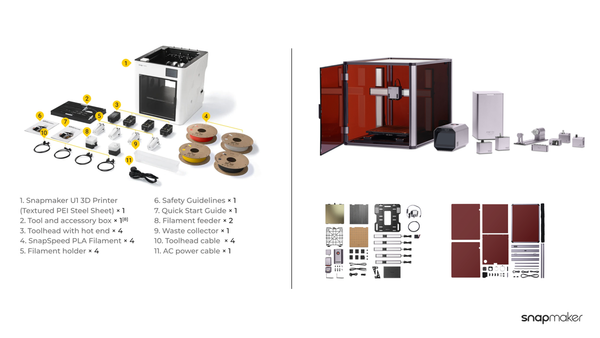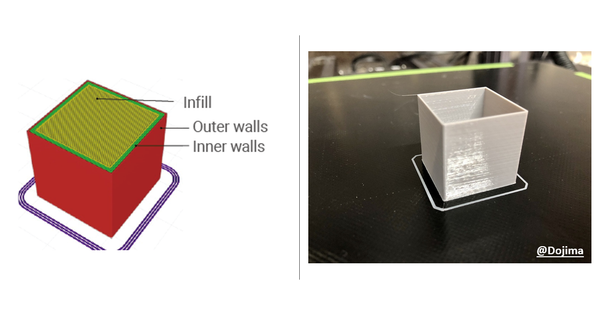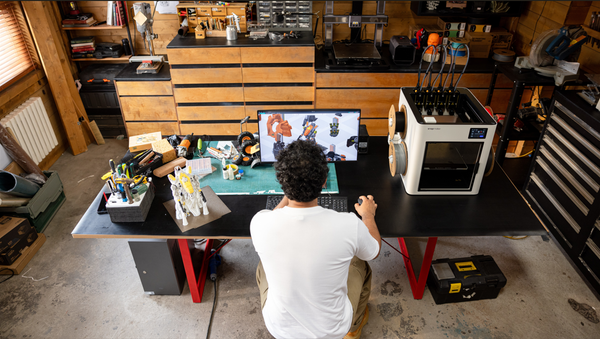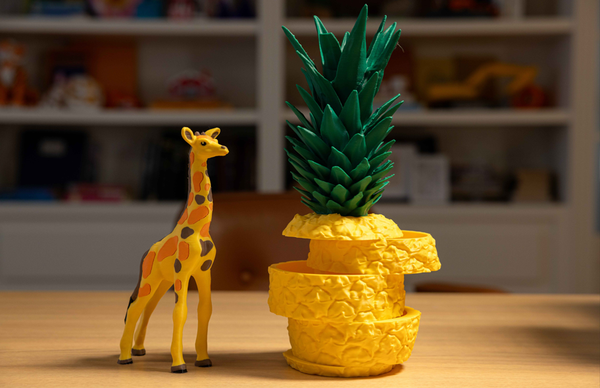StarMaker | An Aquariums with Windmill and Grassland
I’m Aki, an engineer from Japan. I have been doing aquariums for over 10 years and It’s my strong point. When I knew that the contest was about plants, I immediately decided to use aquatic plants as my key idea. I then came up with several ideas to represent spring with aquatic plants.
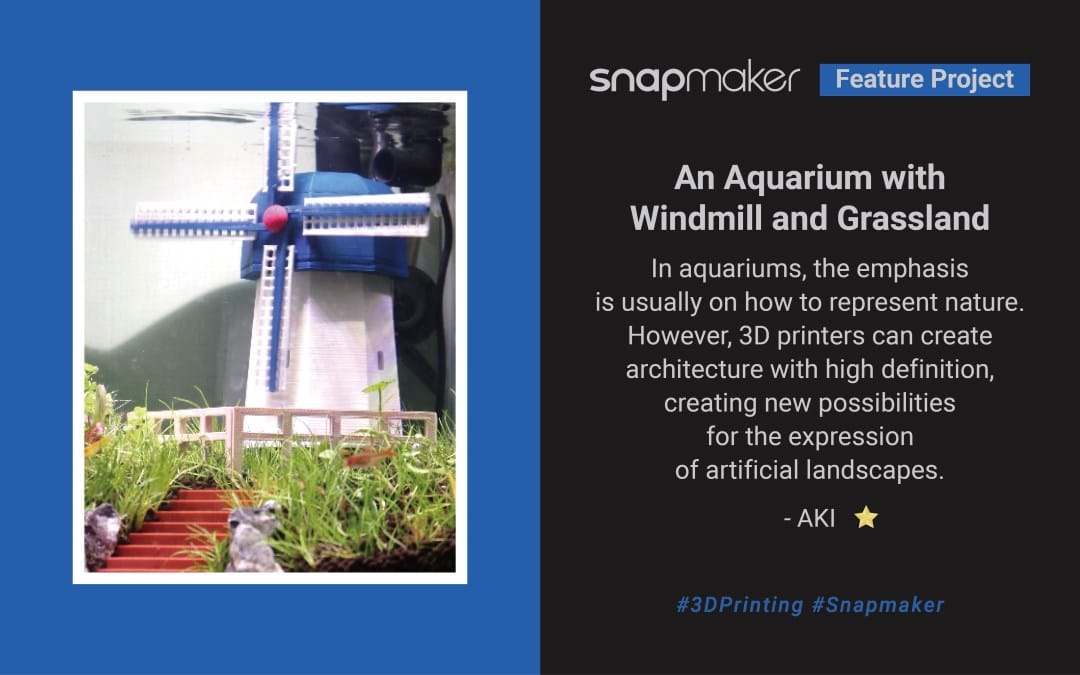
Project: The Windmill and Grassland
Printed by: Aki
3D Printer: Snapmaker 2.0 A250T
Software: Fusion 360, Snapmaker Luban
Materials:
・PLA Filament (7 colors)
・Aquarium Soil
・Aquatic plants (6 types)
Living things:
・Tropical Fish (2 types)
・Shrimp
Equipments:
・Water tank (25cm glass cube)
・LED (For growing water plants)
・Filter (For water quality improvement)
・Water Pump (For rotating wings of the windmill)
・Heater (For water temperature heating)
Hi Makers,
I’m Aki, an engineer from Japan. This is my entry work for the 9th Snapmaking Contest, ”Revive in Spring.”
I really wanted a 10W Laser Module (winning prize), so I challenged myself to enter this contest and won a prize.
I have been doing aquariums for over 10 years, and it’s my strong point. When I knew that the contest was about plants, I immediately decided to use aquatic plants as my key idea. I then came up with several ideas to represent spring with aquatic plants.
The first idea was to create a Japanese castle and cherry blossoms in the water tank to recreate ‘Hanami’. ‘Hanami’ is the Japanese culture of drinking and eating while viewing cherry blossoms in the spring, and in my area, it is popular to do so under a castle.
However, this idea would have required a complex structure, which would have been difficult for my design skills. And there are a few water plants to represent small pink flowers.
So I wanted to make it simpler and smaller but more dynamic and fresh. I chose a windmill with moving parts made by the 3D printer and a green grassland that was matched by the revival of spring.
In addition, I also added small colorful shrimp and tropical fish that match the spring grassland. The shrimp eat moss and help maintain the aquatic plants.
I wanted to show the movement of the windmill and the activity of the creatures, so I entered the contest with a video. If you would like to see it, please visit the contest result page.
Notes:
- The effect of PLA materials on water quality is minimal, but I do not guarantee that all manufacturers' materials are healthy. Please know the risk.
- Some filaments may lose their color over time in the water.
- It is not that difficult to keep tropical fish and shrimp or grow aquatic plants, but if you are a beginner, it’s recommended that you research how to grow them beforehand. Although a heater does not appear in this work, it is necessary to warm the water temperature during the cold season. (e.g., tropical fish:20℃<, shrimp:10℃<) Aquatic plants grow better with dedicated LEDs and CO2 addition.
The Making process:
- Think about the general structure and functions you want to include.
- Design each part taking into account dimensions and shape.
- Prototype each component and test if functionality can be achieved.
- Combine each component and set up the aquarium.
2-3 processes are now much more efficient and easier than in the past, thanks to free modeling software and 3D printers like Snapmaker. I recommend that you make minor modifications over several iterations without thinking too hard.
1 Structure and Functions
For the windmill, I provided the function of rotating blades and a structure to hide the filter for a better appearance.
As for the grassland, the back of the tank is higher, and creates a foundation and steps as an accent to enhance the windmill.In addition, the rotation of the blades can be remotely controlled by a switch from an iPad. This is done by using Apple Homekit compatible power strip.
First, draw a picture of what you want to make. You can draw by hand or use painting software. I often use Microsoft PowerPointbecause I'm a terrible painter.
2 Design dimensions and Shape
Once conceptualized, the design process begins. Measure the shape and size of each part and design them in software. In order to rotate the windmill blades slowly, I useda stream of water to turn them. All the parts are laid out, and the 3D models show how it will look when completed.
3 Prototype and test
This is where Snapmaker comes in.Even if the entire process of 2 is not completed, print and test each part and adjust the model repeatedly to make each part better.
In particular, moving parts and filter inlet were implemented individually until they work well.
4 Set up the aquarium
After the parts are completed, they are assembled into the aquarium. All PLA objects float on water, so they require a weight to be placed inside. I used some flat stones, and the space for them should be taken into account when designing.
After assembly is complete, lay out the soil and plant the aquatic plants. When that's done, fill with water and activate the LEDs and filter. Aquatic plants can be bought at a tropical fish store. I had an idea of the type of water plants to use beforehand, but when I was looking at the items at the store, I remembered my original concept of cherry blossoms and decided to add a few reddish water plants as well. This idea also turned out to be a nice accent.
Immediately after the water is added, it is muddy and the water quality is not stable, so wait a few days before adding living creatures. The time it takes for the water to stabilize will vary depending on the water used, so please refer to the information on tropical fish keeping in your area.
When the water becomes clear, add shrimp and fish. Regular cleaning of the glass surface and water changes will keep it in good condition.
Afterword:
At the time of this writing, more than 1 month has passed since the contest, the water plants have grown even more, and it's time to trim each plant. The shrimp had embraced eggs, and the fish were healthy.
In aquariums, the emphasis is usually on how to represent nature. However, 3D printers can create architecture with high definition, creating new possibilities for the expression of artificial landscapes.
In the future, new works may appear in the aquarium community as well.

